harmony 鸿蒙Building the First ArkTS Application in Stage Model
Building the First ArkTS Application in Stage Model
NOTE
In this document, DevEco Studio 4.0 Beta2 is used. You can download it here.
Creating an ArkTS Project
The procedure for creating a project varies, depending on whether the API version is later than 9 or not.
The following describes how to create the OpenHarmony projects of API 10 and API 9.
Creating a Project of API Version 10
If you are opening DevEco Studio for the first time, click Create Project. If a project is already open, choose File > New > Create Project from the menu bar.
On the Choose Your Ability Template page, select Application (or Atomic Service, depending on your project), select Empty Ability as the template, and click Next.

- On the project configuration page, set Compile SDK to 3.1.0(API 9) and retain the default values for other parameters.
The Node parameter sets the Node.js version to use for the project. You can use an existing version or download a new one.
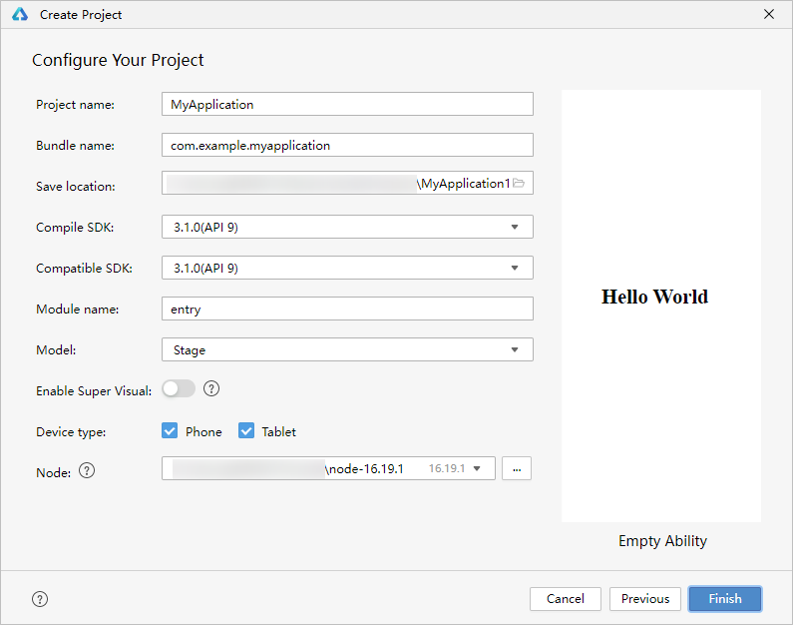
NOTE
You can use the low-code development mode apart from the traditional coding approach.
On the low-code development pages, you can design your application UI in an efficient, intuitive manner, with a wide array of UI editing features.
To use the low-code development mode, turn on Enable Super Visual on the page shown above.
Click Finish. DevEco Studio will automatically generate the sample code and resources that match your project type. Wait until the project is created.
After the project is created, in the project-level build-profile.json5 file (at the same directory level as entry), move the compileSdkVersion and compatibleSdkVersion fields from under app to under the current products. You can identify the current products by clicking the
 icon in the upper right corner of the editing area.
icon in the upper right corner of the editing area.
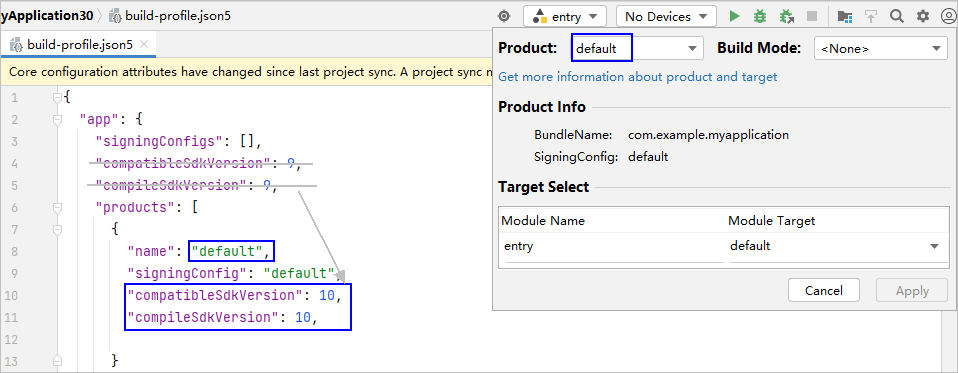
- Change the value of targetSdkVersion from 9 to 10 and set runtimeOS to OpenHarmony.
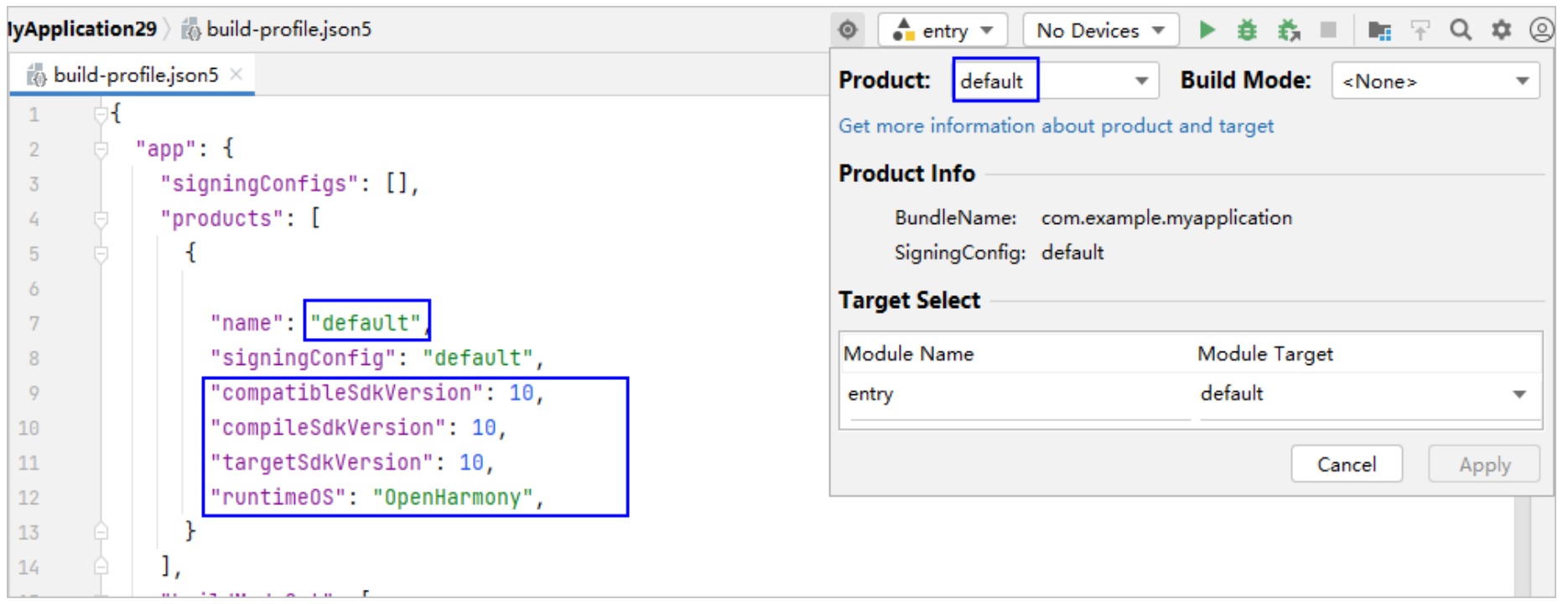
- Delete the runtimeOS configuration from the targets field in the module-level build-profile.json5 files.
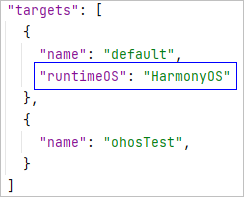
- Click Sync Now and wait until the synchronization is complete. A project of API version 10 is now created.
Creating a Project of API Version 9
If you are opening DevEco Studio for the first time, click Create Project. If a project is already open, choose File > New > Create Project from the menu bar.
On the Choose Your Ability Template page, select Application (or Atomic Service, depending on your project), select Empty Ability as the template, and click Next.

- On the project configuration page, set Compile SDK to 3.1.0(API 9) and retain the default values for other parameters.
The Node parameter sets the Node.js version to use for the project. You can use an existing version or download a new one.

NOTE
You can use the low-code development mode apart from the traditional coding approach.
On the low-code development pages, you can design your application UI in an efficient, intuitive manner, with a wide array of UI editing features.
To use the low-code development mode, turn on Enable Super Visual on the page shown above.
Click Finish. DevEco Studio will automatically generate the sample code and resources that match your project type. Wait until the project is created.
In the module-level entry > build-profile.json5 file, set runtimeOS in targets to OpenHarmony.
Click Sync Now and wait until the synchronization is complete. A project of API version 9 is now created.
ArkTS Project Directory Structure (Stage Model, API Version 10)
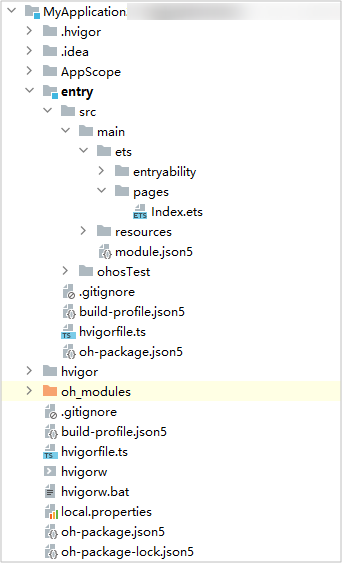
AppScope > app.json5: application-level configuration information.
entry: OpenHarmony project module, which can be built into an ability package (HAP).
src > main > ets: a collection of ArkTS source code.
src > main > ets > entryability: entry to your application/service.
src > main > ets > pages: pages included in your application/service.
src > main > resources: a collection of resource files used by your application/service, such as graphics, multimedia, character strings, and layout files. For details about resource files, see Resource Categories and Access.
src > main > module.json5: module configuration file. This file describes the global configuration information of the application/service, the device-specific configuration information, and the configuration information of the HAP file. For details, see module.json5 Configuration File.
build-profile.json5: current module information and build configuration options, including buildOption and targets.
hvigorfile.ts: module-level build script. You can customize related tasks and code implementation in this file.
oh_modules: third-party library dependency information. For details about how to adapt a historical npm project to ohpm, see Manually Migrating Historical Projects.
build-profile.json5: application-level configuration information, including the signingConfigs and products configuration. The runtimeOS field in products indicates the runtime OS. Its default value is HarmonyOS. If you are developing an OpenHarmony application, change the value to OpenHarmony.
hvigorfile.ts: application-level build script.
ArkTS Project Directory Structure (Stage Model, API Version 9)

AppScope > app.json5: application-level configuration information.
entry: OpenHarmony project module, which can be built into an ability package (HAP).
src > main > ets: a collection of ArkTS source code.
src > main > ets > entryability: entry to your application/service.
src > main > ets > pages: pages included in your application/service.
src > main > resources: a collection of resource files used by your application/service, such as graphics, multimedia, character strings, and layout files. For details about resource files, see Resource Categories and Access.
src > main > module.json5: module configuration file. This file describes the global configuration information of the application/service, the device-specific configuration information, and the configuration information of the HAP file. For details, see module.json5 Configuration File.
build-profile.json5: current module information and build configuration options, including buildOption and targets. The runtimeOS field in targets indicates the runtime OS. Its default value is HarmonyOS. If you are developing an OpenHarmony application, change the value to OpenHarmony.
hvigorfile.ts: module-level build script. You can customize related tasks and code implementation in this file.
oh_modules: third-party library dependency information. For details about how to adapt a historical npm project to ohpm, see Manually Migrating Historical Projects.
build-profile.json5: application-level configuration information, including the signingConfigs and products configuration.
hvigorfile.ts: application-level build script.
Building the First Page
- Use the <Text> component.
After the project synchronization is complete, choose entry > src > main > ets > pages in the Project window and open the Index.ets file. You can see that the file contains a <Text> component. The sample code in the Index.ets file is shown below:
// Index.ets
@Entry
@Component
struct Index {
@State message: string = 'Hello World'
build() {
Row() {
Column() {
Text(this.message)
.fontSize(50)
.fontWeight(FontWeight.Bold)
}
.width('100%')
}
.height('100%')
}
}
- Add a <Button> component.
On the default page, add a <Button> component to respond to user clicks and implement redirection to another page. The sample code in the Index.ets file is shown below:
// Index.ets
@Entry
@Component
struct Index {
@State message: string = 'Hello World'
build() {
Row() {
Column() {
Text(this.message)
.fontSize(50)
.fontWeight(FontWeight.Bold)
// Add a button to respond to user clicks.
Button() {
Text('Next')
.fontSize(30)
.fontWeight(FontWeight.Bold)
}
.type(ButtonType.Capsule)
.margin({
top: 20
})
.backgroundColor('#0D9FFB')
.width('40%')
.height('5%')
}
.width('100%')
}
.height('100%')
}
}
- On the toolbar in the upper right corner of the editing window, click Previewer. Below is how the first page looks in the Previewer.

Building the Second Page
Create the second page.
- Create the second page file: In the Project window, choose entry > src > main > ets. Right-click the pages folder, choose New > ArkTS File, name the page Second, and click Finish. Below is the structure of the Second folder.
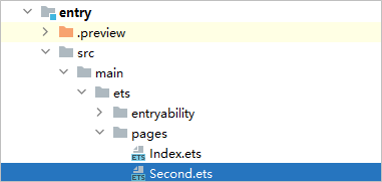
NOTE
You can also right-click the pages folder and choose New > Page from the shortcut menu. In this scenario, you do not need to manually configure page routes. - Configure the route for the second page: In the Project window, choose entry > src > main > resources > base > profile. In the main_pages.json file, set pages/Second under src. The sample code is as follows:
{ "src": [ "pages/Index", "pages/Second" ] }Add <Text> and <Button> components.
Add <Text> and <Button> components and set their styles, by referring to the first page. The sample code in the Second.ets file is shown below:
// Second.ets
@Entry
@Component
struct Second {
@State message: string = 'Hi there'
build() {
Row() {
Column() {
Text(this.message)
.fontSize(50)
.fontWeight(FontWeight.Bold)
Button() {
Text('Back')
.fontSize(25)
.fontWeight(FontWeight.Bold)
}
.type(ButtonType.Capsule)
.margin({
top: 20
})
.backgroundColor('#0D9FFB')
.width('40%')
.height('5%')
}
.width('100%')
}
.height('100%')
}
}
Implementing Page Redirection
You can implement page redirection through the page router, which finds the target page based on the page URL. Import the router module and then perform the steps below:
- Implement redirection from the first page to the second page.
In the Index.ets file of the first page, bind the onClick event to the Next button so that clicking the button redirects the user to the second page. The sample code in the Index.ets file is shown below:
// Index.ets
// Import the router module.
import router from '@ohos.router';
import { BusinessError } from '@ohos.base';
@Entry
@Component
struct Index {
@State message: string = 'Hello World'
build() {
Row() {
Column() {
Text(this.message)
.fontSize(50)
.fontWeight(FontWeight.Bold)
// Add a button to respond to user clicks.
Button() {
Text('Next')
.fontSize(30)
.fontWeight(FontWeight.Bold)
}
.type(ButtonType.Capsule)
.margin({
top: 20
})
.backgroundColor('#0D9FFB')
.width('40%')
.height('5%')
// Bind the onClick event to the Next button so that clicking the button redirects the user to the second page.
.onClick(() => {
console.info(`Succeeded in clicking the 'Next' button.`)
// Go to the second page.
router.pushUrl({ url: 'pages/Second' }).then(() => {
console.info('Succeeded in jumping to the second page.')
}).catch((err: BusinessError) => {
console.error(`Failed to jump to the second page.Code is ${err.code}, message is ${err.message}`)
})
})
}
.width('100%')
}
.height('100%')
}
}
- Implement redirection from the second page to the first page.
In the Second.ets file of the second page, bind the onClick event to the Back button so that clicking the button redirects the user back to the first page. The sample code in the Second.ets file is shown below:
// Second.ets
// Import the router module.
import router from '@ohos.router';
import { BusinessError } from '@ohos.base';
@Entry
@Component
struct Second {
@State message: string = 'Hi there'
build() {
Row() {
Column() {
Text(this.message)
.fontSize(50)
.fontWeight(FontWeight.Bold)
Button() {
Text('Back')
.fontSize(25)
.fontWeight(FontWeight.Bold)
}
.type(ButtonType.Capsule)
.margin({
top: 20
})
.backgroundColor('#0D9FFB')
.width('40%')
.height('5%')
// Bind the onClick event to the Back button so that clicking the button redirects the user back to the first page.
.onClick(() => {
console.info(`Succeeded in clicking the 'Back' button.`)
try {
// Return to the first page.
router.back()
console.info('Succeeded in returning to the first page.')
} catch (err) {
let code = (err as BusinessError).code;
let message = (err as BusinessError).message;
console.error(`Failed to return to the first page.Code is ${code}, message is ${message}`)
}
})
}
.width('100%')
}
.height('100%')
}
}
- Open the Index.ets file and click
 in the Previewer to refresh the file. The display effect is shown in the figure below.
in the Previewer to refresh the file. The display effect is shown in the figure below.
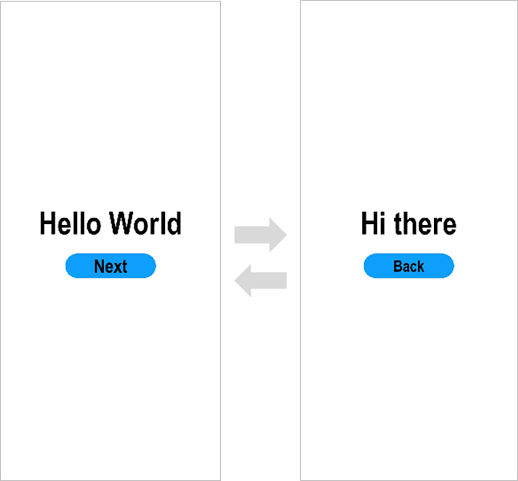
Running the Application on a Real Device
Connect the development board running the OpenHarmony standard system to the computer.
Choose File > Project Structure… > Project > SigningConfigs, and select Automatically generate signature. Wait until the automatic signing is complete, and click OK. See the following figure.
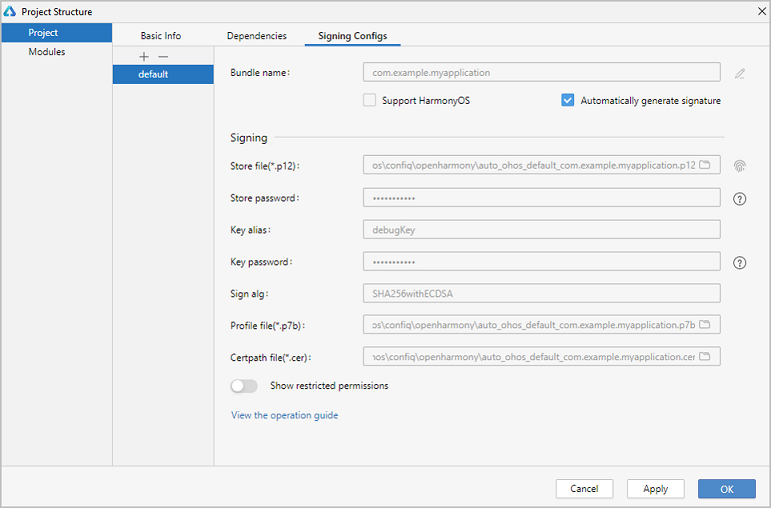
- On the toolbar in the upper right corner of the editing window, click
 . The display effect is shown in the figure below.
. The display effect is shown in the figure below.

Congratulations! You have finished developing your OpenHarmony application in ArkTS in the stage model. To learn more about OpenHarmony application development, see Application Development Overview.
你可能感兴趣的鸿蒙文章
harmony 鸿蒙app.json5 Configuration File
harmony 鸿蒙Internal Structure of the app Tag
harmony 鸿蒙Application Configuration File Overview (FA Model)
harmony 鸿蒙Application Configuration File Overview (Stage Model)
harmony 鸿蒙Application Installation and Uninstallation Process
harmony 鸿蒙Application Package Overview
harmony 鸿蒙Application Package Structure in FA Model
- 所属分类: 后端技术
- 本文标签:
热门推荐
-
2、 - 优质文章
-
3、 gate.io
-
8、 golang
-
9、 openharmony
-
10、 Vue中input框自动聚焦